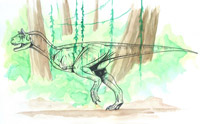Disambiguation Link – Carnotaurus sastrei (S/F), Carnotaurus sastei “gigas” (IDW-JPR), Carnotaurus sastei (JN)
Carnotaurus, “meat-eating bull,” was discovered, described, and named by José F. Bonaparte in 1985; its fossils were found in Patagonia. Carnotaurus lived during the Late Cretaceous about 75 million years ago, and measured about 7.5 m (25 ft) in length, 3.5 m (10 ft) in height, and weighed up to a ton (1000 kilograms). It was an abelisaurid, a group of theropods known for their shorter snouts and reduced arms, that was closely related to the Madagascan Manjungatholus. Its most distinguishing characteristics were the two large, horn-like projections above its eyes, an unusually long neck for an abelisaur, four-fingered and immobile hands, and bumps along its skin as evidenced by fossilized impressions of its skin. Carnotaurus‘ jaw structure shows that it was likely capable of fast but weak bites.
A pair of carnotaurs were briefly seen during the 1995 expeditions to Isla Sorna in the Village. Described as “seven feet tall,” the carnotaurs blended into plants near a chain link fence. Richard Levine was perplexed by the seemingly rippling fence, and the carnotaurs were exposed when Sarah Harding turned on the lights, causing the dinosaurs to showcase their special abilities: Carnotaurus appeared to have excellent camouflage abilities, able to quickly and very accurately imitate any environment that it found itself in. As the lights were turned on, the carnotaurs changed color to match the new light level, turning “a chalky white” in the process. Ultimately, they were driven off when Sarah and Levine shone flashlights on them, causing the dinosaurs to lose their ability to accurately imitate the environment and leave the village, their protective advantage gone.
No information is available as to whether or not the carnotaurs were breeding, what their population was, or what version of the animal they were.


